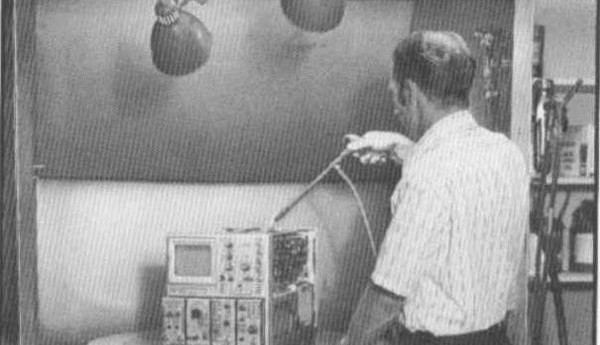Saturday afternoon: give your oscilloscope a good wash-down
December 10, 2015
on
on

I know electronic engineers who start crying in disbelief, calling me names, and pulling what’s left of their hairs, on hearing that a piece of test equipment like an oscilloscope is best cleaned with… water. Others nod, confirming that it can be done and the method is not Fred-in-the-Shed.
Back in the 1960s and 1970s, Tektronix offered a washing service for their instruments, and the method was detailed in two articles that appeared in TekScope magazine in 1972 and 1976. The articles were written by Product Service Technician Charles Phillips. The washing was offered as part of a total repair and calibration program offered by Tekronix to (rich and lazy) customers. Some customers with large numbers of Tek instruments appear to have installed their own wash facilities as an aid in keeping their instruments in top shape. A photo of Charles (Chuck) cheerfully washing a Tek 7000 scope back in 1972 has survived, along with his laconic comment that “[the instruments] are easy to wash and no particular precautions, other than those applying to vacuum tube type instruments, need be observed“. That is professional modesty though.
Apart from a wash booth having an exhaust system to remove dust and mist, and a huge oven, the items you need to do the job effectively include: liquid silver cleaner, brushes, sponge, non-sterile cotton-tip applicators, No-Noise, Kimwipes, WD-40, spray paint, flux remover, Ajax cleaner or equivalent, screwdrivers for removing slotted and Phillips (!) screws. Mind you this is 1972, USA. Add to that: a source of compressed air; a spray gun with 8 feet of hose; a 3-4 feet long rubber siphon hose; hot and cold water; detergent.
I spoke about this with a chemical engineer and he said the crux is the water and the detergent. The water should be the purest you can get, meaning demineralized, deionized, osmosis-treated, i.e. the stuff that does not conduct electricity! Professional window cleaners sell it by the gallon. The detergent should be mild and guaranteed to not leave deposits.
Chuck continued, back in 1972: “We no longer consider it necessary to remove the CRT, shields, vacuum tubes, etc. to do a thorough cleaning job. Experience has shown that warm water and detergent under pressure penetrates these areas adequately without completely exposing them.”
After the washing and rinsing, the instrument (with washed plug-ins installed) was placed in an oven and dried for at least 24 hours. The primary considerations for the oven should be the capability of providing circulating air at a temperature of 125 °F to 150 °F (approx. 50-65 °C i.e. plate preheating mode).
The full story is here and it is not for the faint-hearted or the USB-LCD generation. Sometime in 2016, Retronics, the vintage section in Elektor Magazine and on Elektor TV, intends to retrace Chuck Phillips’ steps with a practical case of an utterly smudged, $10, 1960s oscilloscope being cleaned in the shower and dried in a kitchen oven with the missus out on a shopping excursion. Meanwhile, do not try this at home.
Back in the 1960s and 1970s, Tektronix offered a washing service for their instruments, and the method was detailed in two articles that appeared in TekScope magazine in 1972 and 1976. The articles were written by Product Service Technician Charles Phillips. The washing was offered as part of a total repair and calibration program offered by Tekronix to (rich and lazy) customers. Some customers with large numbers of Tek instruments appear to have installed their own wash facilities as an aid in keeping their instruments in top shape. A photo of Charles (Chuck) cheerfully washing a Tek 7000 scope back in 1972 has survived, along with his laconic comment that “[the instruments] are easy to wash and no particular precautions, other than those applying to vacuum tube type instruments, need be observed“. That is professional modesty though.
Apart from a wash booth having an exhaust system to remove dust and mist, and a huge oven, the items you need to do the job effectively include: liquid silver cleaner, brushes, sponge, non-sterile cotton-tip applicators, No-Noise, Kimwipes, WD-40, spray paint, flux remover, Ajax cleaner or equivalent, screwdrivers for removing slotted and Phillips (!) screws. Mind you this is 1972, USA. Add to that: a source of compressed air; a spray gun with 8 feet of hose; a 3-4 feet long rubber siphon hose; hot and cold water; detergent.
I spoke about this with a chemical engineer and he said the crux is the water and the detergent. The water should be the purest you can get, meaning demineralized, deionized, osmosis-treated, i.e. the stuff that does not conduct electricity! Professional window cleaners sell it by the gallon. The detergent should be mild and guaranteed to not leave deposits.
Chuck continued, back in 1972: “We no longer consider it necessary to remove the CRT, shields, vacuum tubes, etc. to do a thorough cleaning job. Experience has shown that warm water and detergent under pressure penetrates these areas adequately without completely exposing them.”
After the washing and rinsing, the instrument (with washed plug-ins installed) was placed in an oven and dried for at least 24 hours. The primary considerations for the oven should be the capability of providing circulating air at a temperature of 125 °F to 150 °F (approx. 50-65 °C i.e. plate preheating mode).
The full story is here and it is not for the faint-hearted or the USB-LCD generation. Sometime in 2016, Retronics, the vintage section in Elektor Magazine and on Elektor TV, intends to retrace Chuck Phillips’ steps with a practical case of an utterly smudged, $10, 1960s oscilloscope being cleaned in the shower and dried in a kitchen oven with the missus out on a shopping excursion. Meanwhile, do not try this at home.
Read full article
Hide full article


Discussion (6 comments)